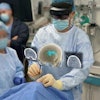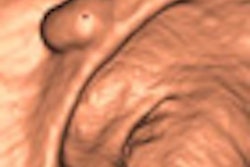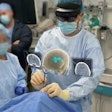Hip and pelvic radiography exams ordered for children younger than 9 years who have nontraumatic, acute onset hip pain are of limited diagnostic value in distinguishing serious disease, such as septic arthritis, from benign disease, such as transient synovitis, which causes inflammation and pain around the hip joint. For this reason, these exams should not be routinely ordered by emergency department or urgent care clinicians.
That's according to emergency department clinicians at Starship Children's Health in Auckland, New Zealand, who made this recommendation after evaluating the records of all children between the ages of 2 and 11 admitted to the Auckland City Hospital Children's Emergency Department with symptoms of hip pain between July 2003 and June 2005. Their findings are published in the February 2009 issue of Pediatric Emergency Care (Vol. 25:2, pp. 78-82).
The majority of children between the ages of 2 and 9 who present with hip pain have transient synovitis, the symptoms of which develop rapidly over one to three days and then dissipate. Symptoms include hip and knee pain, difficulty walking, or a limp, accompanied by fever. Of concern is that these symptoms are similar to a septic, or infected, hip joint. In young adolescents, these symptoms may also indicate a slipped upper femoral epiphysis. Both septic arthritis and slipped upper femoral epiphysis require immediate medical treatment.
Differentiating between these serious and benign pathologies can be difficult. Until this study was performed, the clinical investigation of children presenting with hip pain at Auckland City Hospital routinely included hip and pelvis radiographs and blood analysis. Lead author Dr. Abby Baskett, an advanced trainee in pediatric emergency medicine at Starship Children's Health, and colleagues decided to evaluate the diagnostic value of the radiography exams to determine if and when they could be avoided.
The researchers used both an emergency department database and a radiology information system database to identify patients who either presented with hip pain in the emergency department or had hip and pelvic radiographs in association with symptoms of hip pain. The researchers excluded patients who had a history of previous significant hip pain or hip pain resulting from a traumatic injury, patients whose pain lasted longer than 14 days, and patients who had a significant concurrent illness or comorbidity.
The researchers identified 310 children, of whom 306 (99%) had hip and pelvis radiographs. The group consisted of 202 boys (65% of the total), of whom 167 were younger than 9 and 35 were 9 or older, and 108 (35%) girls, of whom 85 were younger than 9 and 23 were 9 or older.
Radiologists reviewed the hip x-rays of all the patients, categorizing them as positive if the study was reported as abnormal and potentially related to hip pain. A widened joint space alone, for example, was not considered positive. Negative x-rays were normal or only had incidental findings unrelated to hip pain.
Only 1% of the x-rays of patients younger than 9 years old were positive. Three of the 248 radiographs revealed a bone cyst, Perthes disease, or a soft-tissue mass diagnosed as a deep-tissue abscess. By comparison, 9% of the x-rays of children 9 years and older were positive. Four of the 48 radiographs identified upper femoral epiphysis and one radiograph identified Perthes disease.
Fever, weight-bearing status, and age were more accurate predictors of urgent pathology; these variables had a 58% sensitivity, compared to 36% with x-ray for children ages 9 and older and 5% for younger children. X-rays did have a higher specificity of 99%, compared with 89% for the three other variables. Fever was the most important of these variables, according to the authors, who noted that other clinical studies found that symptoms of fever were the strongest predictor of sepsis.
The final diagnoses for the 310 patients was transient synovitis in 86%, slipped upper femoral epiphysis in 1%, and other musculoskeletal disorder in 4%. None of the patients in this cohort had septic arthritis.
By limiting an order for hip and pelvic radiographs to children with more persistent symptoms, the number of x-rays could be significantly reduced, which would limit unnecessary radiation dose exposure, however slight it might be. The authors noted that other clinical studies have shown ultrasound exams to be more sensitive in detecting hip effusions, and MRI is superior to ultrasound for detecting septic arthritis.
By Cynthia E. Keen
AuntMinnie.com staff writer
April 1, 2009
Related Reading
New location recommended for ovarian shielding in girls, March 2, 2009
Finnish study finds unnecessary pediatric CT exams, February 20, 2009
Image Gently organizers look ahead on one year anniversary: Part 1, February 6, 2009
FDA posts pediatric imaging advisory, June 25, 2008
Copyright © 2009 AuntMinnie.com



















